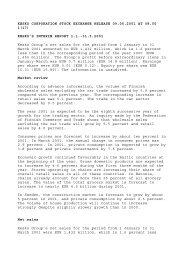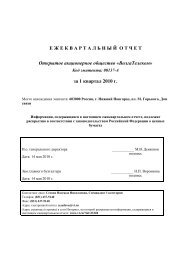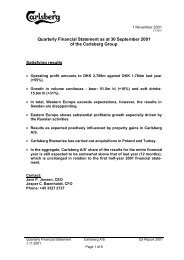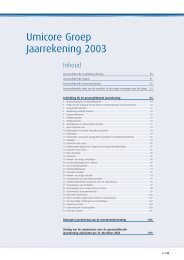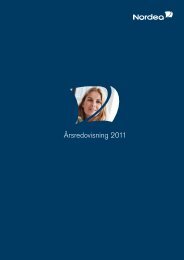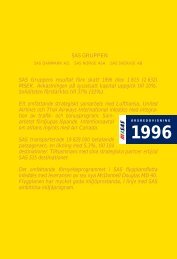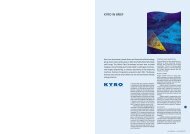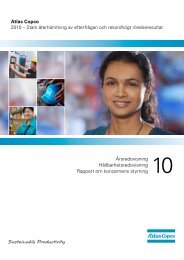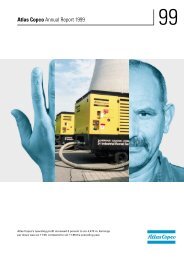össur annual report2009 - Euroland
össur annual report2009 - Euroland
össur annual report2009 - Euroland
You also want an ePaper? Increase the reach of your titles
YUMPU automatically turns print PDFs into web optimized ePapers that Google loves.
Össur hf. consolidated financial stateMents 2009<br />
33.2 significant accounting polices<br />
Details of the significant accounting policies and methods adopted, including the criteria<br />
for recognition, the basis of measurement and the basis on which income and expenses<br />
are recognised, in respect of each class of financial asset, financial liability and equity<br />
instrument are disclosed in note 3 to the Consolidated Financial Statements.<br />
33.3 financial risk ManageMent obJectives<br />
The Company’s Corporate finance function provides services to the business, co-ordinates<br />
access to domestic and international financial markets, monitors and manages<br />
the financial risks relating to the operations of the Company through internal risk reports<br />
which analyse exposures by degree and magnitude of risks. These risks include market<br />
risk (including currency risk, fair value interest rate risk and price risk), credit risk, liquidity<br />
risk and cash flow interest rate risk.<br />
The Company seeks to minimise the effects of these risks by using derivative financial<br />
instruments to hedge these risk exposures. The use of financial derivatives is governed<br />
by the Company’s policies approved by the board of directors, which provide written principles<br />
on foreign exchange risk, interest rate risk, credit risk, the use of financial derivatives<br />
and non-derivative financial instruments, and the investment of excess liquidity. The<br />
Company does not enter into or trade financial instruments, including derivative financial<br />
instruments, for speculative purposes.<br />
33.4 foreign currency risk ManageMent<br />
The Company operates on a global market hence exposure to exchange rate fluctuations<br />
arise. Exchange rate exposures are managed within approved policy parameters. The<br />
general policy is to apply natural exchange rate hedging to the extent possible but the<br />
Company also utilizes forward foreign exchange contracts when appropriate.<br />
The carrying amounts of the Company´s foreign currency denominated monetary assets<br />
and monetary liabilities at the reporting date are as follows:<br />
<strong>annual</strong> report 09<br />
92<br />
LIABILITIES ASSETS<br />
31.12.2009 31.12.2008 31.12.2009 31.12.2008<br />
USD 148,144 156,000 75,052 67,498<br />
EUR 137,838 151,193 62,419 55,936<br />
DKK 0 0 28,563 0<br />
GBP 1,664 1,169 4,407 8,046<br />
SEK 3,055 2,196 5,542 5,370<br />
CAD 532 358 2,445 2,296<br />
Other 5,306 4,905 4,910 2,587<br />
296,540 315,820 183,338 141,732<br />
FOREIGN CURRENCY SENSITIvITY ANALYSIS<br />
The Company is mainly exposed to the currency of Iceland (ISK) and the European Union<br />
(EUR).<br />
The following table details the Company´s sensitivity to a 10% decrease in USD against<br />
the relevant foreign currencies with all other variables fixed. The sensitivity analysis<br />
includes all foreign currency denominated items and adjusts their translation at the period<br />
end for a 10% change in foreign currency rates. The table below indicates the effect on<br />
profit or loss and other equity where USD weakens 10% against the relevant currency. For<br />
a 10% strengthening of USD against the relevant currency, there would be an equal and<br />
opposite impact on the profit or loss and other equity.<br />
EUR (i) ISK (ii)<br />
2009 2008 2009 2008<br />
Profit or loss 2,514 2,549 ( 2,488 ) ( 2,952 )<br />
Other equity 7,792 6,264 305 ( 287 )<br />
(i) 30% (2008: 28%) of the Company´s cost is in EUR against 35% (2008: 32%) of its<br />
total income causing an increase in profit if the USD decreases against the EUR<br />
(ii) This is attributable to the fact that approximately 9% (2008: 10%) of the Company´s<br />
operating cost is in ISK against 0.3% (2008: 0.5%) of its income.<br />
33.5 interest rate risk ManageMent<br />
The Company is exposed to interest rate risk as funds are mainly borrowed at floating<br />
interest rates. Interest rate risk is managed by the Corporate Finance function by maintaining<br />
an appropriate mix between fixed and floating rate borrowings, by the use of interest<br />
rate swap contracts. Hedging activities are evaluated regularly to align with interest<br />
rate views and defined risk appetite; ensuring optimal hedging strategies are applied.



